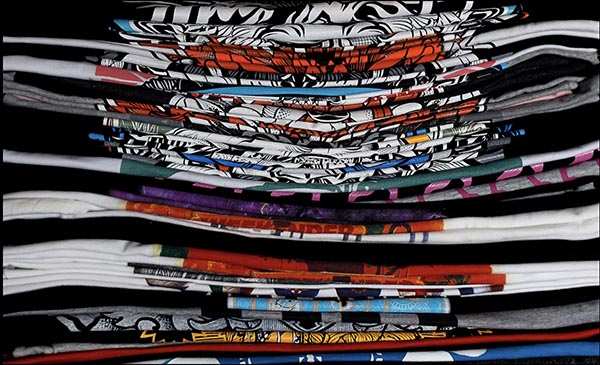
(Image courtesy of Texintel)
Direct-to-garment (DTG) production goes from strength to strength, with a vertical ascent predicted. Stellar growth in the use of DTG digital textile printing machinery continues to provide a unique and highly successful business model, gaining traction worldwide. As a technology built to deliver speed to market, it’s built for on-demand production and as such sustainable manufacturing—driving down inventory and production costs.
The DTG printing market, which stood at US$822 million in 2022, is predicted to rise at annual growth rate of 8.3% to US$1,820 million by 2032 (FMI). This represents a more than doubling in size of the global market over a 10-year period, which many experts attribute to the unique advantages of direct-to-garment printing. These advantages include ease of entry, a “nil finished inventory” business model, and moving in lockstep with the market shift to customization and print-on-demand ecommerce.
As a sector, innovations continue to drive the agenda.
Kornit Digital (KD) has made considerable strides with its inks particularly for polyester fabrics, where its Neopigment™ Olympia ink is its unique, innovative ink for high-quality printing on polyester, delivering a wider color gamut, solid color coverage, and precise Pantone color-matching. This eco-friendly ink is manufactured in-house and specifically designed for Kornit systems to meet the highest sustainability standards.
Outstanding durability and hand feel with a higher L value and opacity for bright prints are achieved, along with increased strength and flexibility to improve print elongation. All of these attributes ensure that the KD machinery achieves the highest retail quality and durability standards.
Set for perhaps even greater success is DTF (direct-to-film) technology. Innovations in this area of print are thick and fast for on-demand garment production. DTF printing is one of the most versatile techniques available in the print industry, with incredible color vibrancy and ultimate fabric versatility. With a DTF print, you can work with tougher fabric varieties like polyester, fleece, nylon, and of course classic cotton.
DTF printing involves printing a design onto a piece of PET film (a special film with a coating that helps transfer designs) using water-based inks and a special powder adhesive. Then, the design on the PET film is heat transferred to fabric using a heat press. This printing method is durable and the design’s print quality is impressive, detailed, and the colors vibrant.
Leaders in this field include Roland DG with its BN-20d, Mutoh with its VJ 628d, and Sublistar with its DTF 6002 Pro max DTF line. Ricoh also offers DTF printer options.
As far as supply goes, there is an abundance of apparel blanks manufacturers who are queuing up to supply the DTG industry. From Fruit of the Loom and Bella Canvas in America to numerous wholesalers throughout Europe, the prospective producer has access to the widest range of blank apparel, from T-shirts and hoodies to sweatshirts and V-necks. Consumers now demand responsibly-sourced apparel, and in the DTG arena the sourcing routes are adapting to assure that organic, certified cellulose and rPET recycled polyester print bases are in good supply.
For sheer production at price, the Brother GTX Pro bulk is the ticket, for it can produce 14,000 T-shirts a week on a single eight-hour shift. Brother DTG Direct to Garment Printer Inks are manufactured according to Brother DTG’s exclusive formulation, providing the best possible results from a DTG printer.
These Brother Direct to Garment Printer Inks are among the first to not only carry the Oeko-Tex® Certification, but also to be GOTS APPROVED and CPSIA-compliant to help ensure they are safe for printing and are environmentally responsible. They also boast the best washfastness results in the DTG industry.
Looking to the year ahead, providing the ultimate in speed, efficiency, flexibility, and profitability we arrive at back the Kornit Digital range of DTG machines.
As if the XDI profile ink system isn’t enough, Kornit machines from the Atlas to the Vulcan provide the perfect platform for an up-to-date and profitable digital printroom and, in 2023, Kornit is about to promote its new Apollo system. The manufacturer recently unveiled the Apollo machine, which uses its Max technology to offer “the highest retail quality combined with full automation control and integrated smart curing processes.”
The printer also utilizes technology from Lichtenau, Germany-based Tesoma, Kornit’s most recent acquisition. Kornit said, “the single-step end-to-end system addresses accelerated post-pandemic market trends for streamlined supply chains and production nearshoring.”
It is expected to be available in mid-2023, following early customer engagements in the second half of 2022.
So, with innovation, efficiency, and speed of production, the direct-to-garment industry moves inexorably upward.
The machinery agenda has also moved apace: we are witnessing the dawn of the hybrid. Of particular attention is the development of hybrid DTG printing, where screen printing and digital printing are combined on one platform. A stand-out here is the Kyo Hybrid DTG Printer from Aeoon of Austria. The Kyo Hybrid Series is the first real combination of screen and digital textile printing that combines the advantages of both. It is the ideal printer for companies with high-volume production needs and offers a unique set of production flexibility.
In addition to standalone DTG printing or screen printing, a combination of both printing processes can also be easily integrated. This combination achieves significant savings in the consumption of white ink while delivering a premier finish.
From Inkthreadable to Printful, the DTG success stories abound, as the DTG sector, driven by all these factors, begins to meet the market expectations of a textile segment with substantial and irreversible growth. With DTF technologies and hybrid print solutions now added to the mix, there is a lot to look forward in the years ahead.














